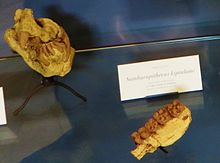
Back Samburupitec Catalan Samburupithecus German Samburupithecus French Samburupithecus Dutch Samburupithecus Portuguese Samburupithecus Turkish Самбурупітек Ukrainian
| Samburupithecus Temporal range:
| |
|---|---|

| |
| Samburupithecus kiptalami fossils, Muséum national d'histoire naturelle, Paris | |
| Scientific classification | |
| Domain: | Eukaryota |
| Kingdom: | Animalia |
| Phylum: | Chordata |
| Class: | Mammalia |
| Order: | Primates |
| Suborder: | Haplorhini |
| Infraorder: | Simiiformes |
| Superfamily: | Hominoidea |
| Family: | incertae sedis |
| Genus: | †Samburupithecus Ishida & Pickford 1997 |
| Species: | †S. kiptalami
|
| Binomial name | |
| †Samburupithecus kiptalami | |
Samburupithecus is an extinct primate that lived in Kenya during the middle to late Miocene. The one species in this genus, Samburupithecus kiptalami, is known only from a maxilla fragment dated to 9.5 million years ago discovered in 1982[1] and formally described by Ishida & Pickford 1997.[2] The type specimen KNM-SH 8531 was discovered by the Joint Japan-Kenya Expedition at the SH22 fossil site in the Samburu District,[1] a locality where several other researchers found no ape fossils.[3]
Samburupithecus lived during the so-called "African ape gap" 14 to 7 Ma, a period from which very few hominoid fossils have been found in Africa until relatively recently.[3] This apparent gap, however, is now populated by a diversity of apes such as Nakalipithecus, Chororapithecus abyssinicus,[3] Otavipithecus,[4] and Nacholapithecus.[5]
- ^ a b Yasui, Nakano & Ishida 1987
- ^ Ward & Duren 2002, p. 395
- ^ a b c Bernor 2007
- ^ Ward & Duren 2002, p. 386
- ^ Sawada, Y.; Saneyoshi, M.; Nakayama, K.; Sakai, T.; Itaya, T.; Hyodo, M.; Mukokya, Y.; Pickford, M.; Senut, B.; Tanaka, S. (2006). "The Ages and Geological Backgrounds of Miocene Hominoids Nacholapithecus, Samburupithecus, and Orrorin from Kenya". Human Origins and Environmental Backgrounds. Developments in Primatology: Progress and Prospects. Springer. pp. 71–96. doi:10.1007/0-387-29798-7_6. ISBN 978-0-387-29638-8.
© MMXXIII Rich X Search. We shall prevail. All rights reserved. Rich X Search